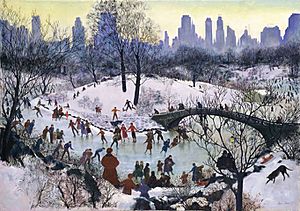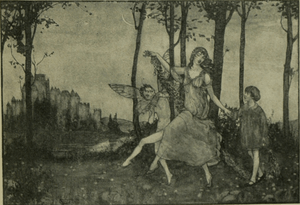Agnes Tait facts for kids
Quick facts for kids
Agnes Tait
|
|
|---|---|
| Born | June 14, 1894 New York City
|
| Died | August 23, 1981 (aged 87) Santa Fe, New Mexico
|
| Nationality | American |
| Education | Leon Kroll |
| Alma mater | National Academy of Design École des Beaux-Arts |
| Known for | Painting, printmaking, children's book illustrations |
|
Notable work
|
Skating in Central Park |
| Spouse(s) | William McNulty |
Agnes Tait (1894–1981) was a talented American artist. She was known for her paintings, drawings, and prints. Agnes also illustrated children's books and painted large murals. She even started her career as a dancer!
Contents
Growing Up and Early Art Life
Agnes Tait was born in Greenwich Village in New York City. Her parents were Anita Innocentia McCarthy and John C. Tait. Agnes secretly applied to the National Academy of Design. Her parents were surprised but happy she got in, especially since tuition was free.
She studied there from 1908 to 1916. Agnes took classes in drawing and painting. She won several awards for her artwork during this time. After graduating, she returned home to care for her sick father. Agnes wanted to be both a painter and a dancer. She painted during the day and danced in a chorus line at night. She kept this busy schedule until her father passed away in 1919.
Becoming a Professional Artist
Agnes Tait began showing her art in 1915. Her work appeared in big art shows across the country. In 1927, she traveled to Paris, France, to study printmaking. When she returned to New York, she rented her own art studio.
She showed her art to a gallery owner named Valentine Dudensing. He was very impressed with her work. He then organized an exhibit featuring Agnes's paintings. One of her paintings, Melancholia, was even mentioned in The New York Times. Another painting, The Bride, was shown at the Art Institute of Chicago. It was very popular with visitors.
Her success allowed her to travel to Europe, Jamaica, and Haiti. She got paid to create art for different people.
Art During Hard Times
The Great Depression made it hard for artists to sell their work. Galleries asked Agnes to paint portraits of famous people. They hoped this would attract buyers. Her portraits received good reviews.
In 1933, Agnes went to Europe again with her husband, William McNulty. When they came back, she joined the Public Works of Art Project (PWAP). This project hired artists to create art for government buildings. Agnes was very thankful for this chance.
She began working on her most famous painting, Skating in Central Park. This painting showed a mix of old American art styles. It also had influences from a famous artist named Pieter Breughel the Elder. The painting was a big success.
This success led to more work for Agnes. She joined the Federal Art Project. She created more prints and large murals. Her mural Fruits of the Land (1941) can be seen in a post office in Laurinburg, North Carolina. Agnes loved to travel. She visited Trinidad and Dominica. She made a series of prints about her trips.
Illustrating Children's Books
Agnes Tait also illustrated three children's books. These books were Peter & Penny of the Island, Heide, and Paco's Miracle.
Life in New Mexico
In 1941, Agnes and her husband moved to Santa Fe, New Mexico. They moved because her husband's health was not good. In Santa Fe, Agnes discovered the Fine Arts Museum. She began painting beautiful Southwestern landscapes.
In 1943, one of her prints, El Cristo Rey, was chosen for a big art show. It was held at the Library of Congress. Another print, Survivors, was also selected for an exhibition. These successes encouraged her to have her own art shows. She had shows in New York and Santa Fe.
In 1945, the Fine Art Museum of New Mexico held a special show of Agnes's work. This show traveled to several cities in the Southwest. During this time, her sister and husband faced health problems. Agnes found comfort in painting cats. She continued to paint portraits and murals.
After 22 years in Santa Fe, Agnes decided to find a new home. She felt she was only seen as a "New Mexico Artist." She wanted to be known for all her art. Agnes once said, "If people want to think of me as a Santa Fe artist, well--let them think anything they want." She traveled to Italy, Ireland, and Florida. Eventually, she returned to Santa Fe. She lived there until she passed away in 1981.
Where You Can See Her Art
Agnes Tait's artwork is in many public collections, including:
See also
 In Spanish: Agnes Tait para niños
In Spanish: Agnes Tait para niños



